Ania Bas (b. 1981, Poland) is an artist who works with people and with language. Bas’ practice is social, dialogical, interdisciplinary and inspired by everyday life. Bas’ practice investigates connections with places and people and takes forms of events, performances, actions and interventions. The works often have their second life as texts, visual essays and publications. Bas’ practice takes place in live environments rather than in a studio. She works with groups and individuals, businesses, schools, galleries, markets. Bas was a resident artist at Whitechapel Gallery London, Yorkshire Artspace in Sheffield, The New Art Gallery Walsall, Ridley Road Market in London, Disonancias, Bilbao in the Basque Country and Vestas Blades on the Isle of Wight.
In the interview, which took the form of a walk along the River Thames from London Bridge to Vauxhall (inspired by the London based Walking Reading Group that Ania has developed with curator Simone Mair) where we encountered seagulls, buskers, tourists, and chattering school children, we talk about Ania’s work (especially Open School East where she is currently an associate artist), about what she is currently reading, the politics surrounding art making and what it means to be an artist.
When did you decide you wanted to be an artist - was there a particular moment?
I don’t know if I ever told you before but I never studied art - it was a bit of a late thing for me. I studied Culture Studies (or the Science of Culture as it says on my diploma). Unlike Culture Studies here in the UK, my course was more centred on anthropology and looking into the behaviour of humans really from many perspectives; my specialism was in ’cultural animation’. The Warsaw University where I studied had an exchange programme with Jubilee Arts which later became The Public and was based in West Bromwich (Birmingham) - so I came over to West Bromwich during my third year in university and this was my introduction to the UK - my first view of what the UK looked like (before I thought it was like Sherlock Holmes figures with everyone wearing suits and hats!). West Bromwich was very different to this expectation. It wasn’t until I moved there that I realised what I was doing is called art here. My Polish tutors would always categorise what I did in the realm of social work. There are Polish artists like Artur Zmijewski and Pawel Althamer who make work with participants which is recognised as art. They expose this participative situation - portraying it not just in relation to the value it has in terms of people coming together, but also in terms of the interaction between groups of people. For example Them by Zmijewski where 4 different groups come together to make signs representing their groups, and attacking each other’s signs depending on their beliefs.
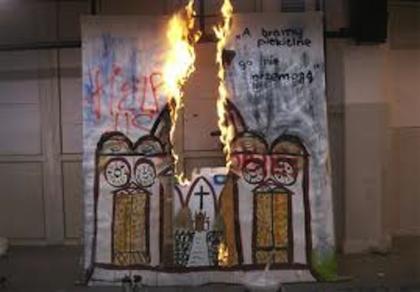
[Still from Them, Artur Zmijewski, 2007]
Yes, I remember seeing it as part of the Double Agent show at the ICA in 2006 - very much a workshop environment but seen through the lens of Zmiejewski, giving powerful insight for the viewer into people’s behaviour in a particular group.
Yes and similarly at the Venice Biennale this year, Blindly by Zmijewski, a film where blind people were asked to paint - again, you have this situation where someone is invited into a space where artistic skills are beneficial, where it doesn’t matter how good or bad you are and whatever emerges is valid. The finished work was not just about the workshop, but exhibited how a person without sight relates to colour, form and the formal themes they were asked to paint - landscape, for example. When I arrived in the UK, I was quite naive about participatory work - I was working with people and taking on board Jubilee Arts’ and my university course’s perspectives - that art should be about bringing people together, levelling social interaction, putting people on the same page, working through issues that are difficult - that art creates a language that people can explore this within, where conflicts emerge rather than them being in any way resolved.
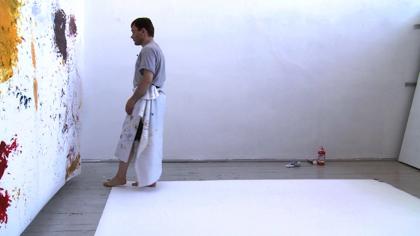
[Still from Blindly, Artur Zmijewski, 2010]
Albert Potrony talked about his work on the participatory Big and Small programme in terms of creating a space for members of the group to see each other differently.. that art creates a space for this to happen. He talked about how his work came full circle from working alone in his studio making work, to working in education settings, to working on a new commission that’s now about his participatory work.
It’s interesting to hear that other artists might look for space to work with people because they feel isolated in the studio - I’ve never had a studio, so there was never that jump for me from working in the studio to making work in participatory settings. My starting point was working with people, however what was always happening in the background when I was working in that way was that I would write, and I wasn’t placing a lot of value on that written work. Only last year did I fully acknowledge that writing is a big part of my practice and something that I do for myself - to prevent me from going mad, to reflect on what’s happening, to channel some of my anxieties out of my head on to paper or computer file! This is an interesting shift as it feels like at the moment many artists are getting to the point where they are saying that their studio practice and their work in participatory settings is part of the same thing, but I never felt like I had to make that jump. For me the jump is acknowledging that working in participatory settings and writing are part of the same thing for me - this is what I’m trying to merge now, to create stronger links between the two. This seems to be the most interesting thing happening in my head right now. I am merging working with people and writing and I am exploring the idea of co-writing, as a way of creating fiction with multiple authors and exploring how this can happen.
The Walking Reading Group that I co-run is in a way an offshoot of wanting to write - I always felt that to be able to write knowledgeably I should read a lot. Reading doesn’t sink in unless I discuss it with others - it is through conversation and debate that I make connections and relate to stuff I read. The TWRG came out of reading and wanting to understand the context I’m operating in, and it is a thorny land.
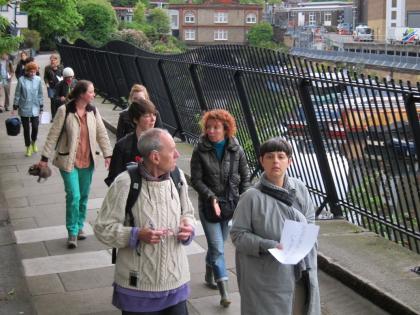
[Image of Walking Reading Group by Saioa Olmo]
It sounds like the TWRG could nearly be seen as an extension of your studio - because you’re working with people and you’re reading? One of my questions was about your studio and what it looks like...
I used to have temporary studios as part of residencies, but I would often convert them into something else, for example a café (whilst in residence in The New Art Gallery in Walsall) or an interview and resource room (whilst in residence at Orleans House Gallery). I do have a studio now through Open School East - I am one of the twelve associates in this experimental and free art school for one academic year. And I am there a minimum of twice a week attending lectures, crits, workshops - but the studio is accessible 24 hours. Mine is pretty empty - it has a desk in it and a board which I pin some stuff to, some of the works on it are ones that I’ve developed in a classroom context with children (interesting work by kids that I’ve photocopied) so it’s not even my work that hangs up there. At the same time, it is my stuff as the young people made it while interacting with me in the classroom. I have this sort of weird relationship to these contexts, as there’s a fine line about who I am coming in as - am I a facilitator, an artist, a service provider which allows for certain things to emerge and things to happen. Is it my project? Is it a co-project? This changes all the time, I don’t think there’s one way of operating.
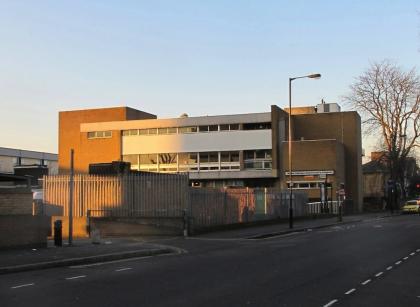
[Image of Open School East]
Albert talked about that in relation to different roles within this process that he plays at different times - leader, facilitator and assistant. There are questions of authorship around this too which I think you’re getting at when you talk about the children’s work on your wall. Is this something you think about a lot?
I think about it now because I’m currently trying to figure out how to make a work that would be potentially text-based / a book - how to ensure that all of the gratification involved in making a book like this doesn’t just come to me, but to other people involved in making something. Usually it’s artists who benefit from making work - they’re the ones who are commissioned again, if the work sells they receive money or they’re the ones that show their work nationally or internationally. The group and participants are just acknowledged as being part of that project. They may use it on their CV etc. but they won’t benefit from their involvement in terms of it leading to shows or commissions of their own. I find it more and more problematic.
I have found this difficult in the past - for instance with the Children’s Art Commission that I worked on in 2012 at the Whitechapel Gallery (Boys and Sculpture by Eva Rothschild) - the participants went voluntarily into the process and from the beginning the artist was clear about what she wanted to get out of it (a new art work) without showing any real interest in the participants. I found it problematic at first, but then I began to welcome the artist’s candour and realised that her perspective didn’t impact on the experience of the participants (which ended up being a very good one), and the work has proved a very interesting piece in relation to the debate around gender and education while perhaps raising the profile of participatory work.
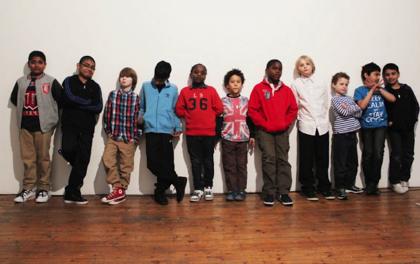
[Image of participants from Boys and Sculpture, Eva Rothschild, 2012]
This is interesting if someone is saying from the beginning that ‘this is my project and I want it to happen in this way’ - it is rare that the contract is said out loud from the beginning and made transparent. Quite often there are situations that I’m part of where the assumption is that we’re making it together and we are all equally important in this process, which is not the reality - there are hierarchies within the group. For instance in a classroom situation, students are not my mates - they call me by my first name but I’m definitely there as someone who oversees the group - not part of it. Quite often I introduce the context for the way we work - the materials - the prompts. Other structures also determine what this relationship is about, but I catch myself using that language, saying ’we’re making it together’. Who gains what from this? I’m trying to be clearer about this in my own head - about what I’m doing and on what terms people are invited to be part of something. For example, the TWRG people were very much coming as participants - no room for them to be collaborators. I collaborate with Simone Mair to make the TWRG happen and everyone else participates. And I think people enjoy it - it has a rigorous structure, clear framework and yet so far I haven’t heard a single person saying they were ’used’ by that structure or that we made them feel uncomfortable..
I think for young people to test and experience situations that occur within art projects where they don’t have total control but there’s the option of being a little bit more in control if they really want or to change the direction of something is very important - to be able to test that kind of agency in a safe place through art. Although perhaps it doesn’t ever go far enough?
Yes I think normally that would be really valid, but what I find more and more frustrating working with schools in the UK (and I don’t know how much you’d like to discuss this) is that from the very beginning I am told that everyone needs to pass - it has to be a successful experience - the work needs to be produced. This puts pressure on producing and there’s very little value placed on the processes themselves and the social skills that might be part of that. It’s about making work that is visible and that can be assessed and marked. I am trying to open up these structures, arts education in secondary schools should be experimental. I enjoy working with primary schools - there’s far more freedom, far more openness about the process and far more space to link up other contexts (art and history - art and biology etc.).
Yes the British secondary schools’ curriculum seems to be regressing in terms of its freedom and experimentation, and yet the visual arts has gone so far in the other direction in terms of its work with people.
I did want to talk to you about your work with schools as a lot of your work with galleries has been with schools. Do you approach your work with different galleries in different ways? Do you notice political differences and agendas?
I work in schools a fair bit. I enjoy long-term involvements like the one I had through Whitechapel Gallery where I could work with same school for a year. The long-term engagement meant that I started seeing the whole school as a site for work, not just working in one classroom with one group of students. Over a year you meet people, they start to trust you and all sort of things then can happen. Time frames determine type of work I can do, type of thinking I can introduce, type of relationships I can develop. When working with schools in gallery settings challenges come from many other angles. Am I here to mediate the exhibition to students? Am I here to make them think about their own work in relation to the work they see? Am I here to expose and discuss the agenda of the institution called ‘gallery’? It is an interesting set of questions and I try to be clear with myself as much as I can what I can achieve in 60min with a group of 25 young people in a highly regulated space where only allowed material apart from one own body is paper and pencil.
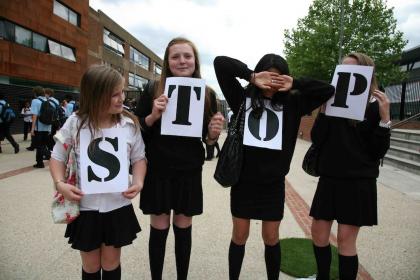
[Whitechapel Gallery Artist in Residence Project, Isles of Silly, 2009]
You worked with us during the summer at the Big and Small Family Day at Tate Britain. How did the context of the Gallery change what you were trying to do? How did you find working with parents/ carers and children as opposed to groups of school children?
Big and Small was a great experience. I don’t think I have seen so many children in the gallery before. It was a rather overwhelming day but in a good way. I was inviting people to spell words that were important to them, chose word and find as many people as letters in the word to spell it. Then we would photograph them and project this image on the wall. It started of with ‘cats’ and ‘dogs’ and words like ‘food’ or ‘sun.’ However, there was a moment when people started connecting letters together with paper clips and spelling names of their children. The photograph became a souvenir and I found it problematic. I found myself producing something that was close to a ‘mass produced commercial object’. Towards the end of the day a woman and a child were looking for letters to spell the boys name and I stopped them and explained that the idea was to spell words they mean something important to them, that explore something about who they are. And this woman said something like, well we won’t spell ‘Jason’ in this case, we will spell ‘autistic’, because Jason is autistic, and it is an important word to us.
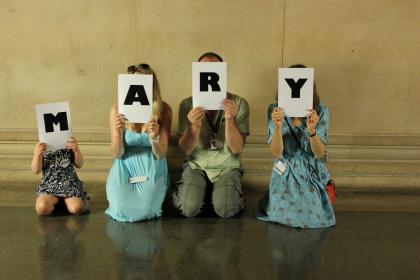
[Image of Ania’s activity for Big and Small family day, 2013]
It’s interesting to see galleries being overtaken by families and children - how differently they behave in that space and what they get out of it. People picnicking in the galleries - I loved it. This is so refreshing to how people would behave usually. I am not too keen on galleries having this vibe of fancy spaces where people are having intellectual chats, I am up for galleries where families can have picnics and intellectual chats are still allowed but not necessary have this aura of exclusivity.
Yes I think that’s one of the purposes of those days - to really promote the idea of families in galleries - I think we’ll always continue to do days like that as they also enable us to be experimental in the way we’re working with artists. But we have been discussing recently how a family day looks very different to a normal visit to a gallery and how that can be an issue as perhaps people won’t come back unless there’s a family event happening. I think we’ll continue to do them to remind people of what a gallery could look like if people fully embraced the idea of early years and families in the gallery, all of the time.
It’s interesting as would you come and have a picnic in the gallery if it was just one family - would you use that space in exactly the same way if there wasn’t that structure that says help yourself, sit down?
And I don’t think there would be - i’ve spoke to parents about this and they have said there’s a power in numbers, and on your own it’s easy to get embarrassed if your child is making noise or behaving differently in comparison to other gallery visitors. It’s about educating the public about this! I think that’s what those family days do too - sometimes we get complaints but recently we’ve got some great feedback from the general public on family days saying how much they’ve enjoyed observing the event.
This leads me to a question about the profile of participatory practice in London and the UK. Is there still a lot of work to be done?
Yes! It’s an interesting question - I’ve heard quite well known artists whose work, which is a lot to do with participation, and has been exhibited in major galleries, speaking about a recent piece of their work, and saying ’yeah and we have to do some workshops as part of that commission too’ as if it was an unwelcome add on. I found that problematic.
Ironically, because of their involvement in that field of practice they raise the profile of that work. But perhaps it happens in the wrong way? It occurs quickly and has an impact but it’s not genuine enough.
In that particular context it sounded like the workshops were part of a deal and it wasn’t necessarily welcomed - they took it on because overall it was a good deal. I think working with people is exciting and rather then forcing artists who don’t want to do it to do it, give it to people who see it as a genuine opportunity and an exciting context.
There’s a lot of bad participatory artwork out there and at the same time there’s this move (in the area of fundraising) about what good participatory practice is and what it looks like. For example, Artworks (the initiative of the Paul Hamlyn Foundation), where they’re talking about how to train artists to be good socially engaged practitioners - I worry that this will lead to accreditation soon, a certificate that will say you’re a good participatory artist - and what does that mean, who gives that stamp of approval?
There is no ideal way of doing it - it depends on the situation, the group, on the artist, on the aims etc?
Yes I would say it’s always context-specific. Loads of people work with single-issue groups - is that doing anything? What is grouping people in their different age groups, ethnic groups or cultural groups achieving (e.g. teenage mothers, gifted and talented young people, Afro Caribbean older people). What does this do to us? I think it is compartmentalising society even more as it wasn’t divided enough.
We actually do that a lot with Big and Small because the funding is quite specific in terms of who we work with. But with the Early Years and Family programme in general I think we’re trying to get away from that categorisation - for example the Yuri Suzuki Juke Box project you saw recently is for people of all ages and doesn’t look like it’s part of a typical family gallery programme - we know that families might particularly enjoy its intergenerational and sensory nature, but we haven’t explicitly stated that it’s an Early Years and Family project because we want everyone to engage with it. I did think on Saturday (at the Tate Britain Housewarming event) it was lovely to to see that at a certain time there were lots of our different ’categories’ of audience all existing together in the gallery very naturally. There aren’t so many public places where this can occur.
Yes, I agree. And maybe the work with specific groups gets to the point where you come on your own - not as part of the group, you come as yourself and engage with the mass that’s there already. That would probably be the ideal situation. To see galleries as public spaces that you have a right to engage with on your own terms. I used to use galleries as a meeting space - I would meet people on a bench in front of a work, it always felt like I was in an American film. A gallery is a nice environment and it used it have far more comfortable seating where you could talk through something not relevant to the gallery at all - a communal place in the city centre. Now they all have pretty posh cafes, but sitting in a café is a different meeting to sitting in front of a work.
If you go into gallery spaces now (Tate is quite unusual as it’s huge), generally there’s rarely any seating area provided - you have to take your little chair with you. Maybe I’m being nostalgic and romantic - but we need more benches, more places to sit and to congregate!
More places to loiter! I wondered it you end up discussing institutions as part of the Open School East project you’re part of - what’s it about and how does it work?
It’s an Art School that want to interact with its locality. All of the 12 associates were artists who were chosen on the basis that they’re interested in doing something in relation to the locality and the school. The school is based in an estate in a building that used to be Hackney archives and children’s library - now it consists of artists’ studios, a nursery and a community hall. The idea is that whatever we do at the school somehow links up to the local area. On the one hand there is the estate, on the other there are million-pound worth houses... so this is where the school is situated - between these 2 distinctly different neighbourhoods in a regeneration area. The school potentially contributes to this version of the regeneration, although Haggerston is already gentrified. We constantly talk about who we are and how we engage with what’s local and what are our agendas.
As part of being at OSE I want to work on a project that looks at narrative and myth-making and I would ideally like to work on this narrative with people who live locally. And this opens up all sorts of questions. Why should anyone care to work with me on writing narratives?
I’m trying not to work with one particular type of group - I’m suspicious about working with just one type of group of people. I don’t find it productive in the longterm and think it contributes to the neat categorisation of society. Unless there’s funding that forces me to do that I’m happier not to do it. I’d prefer to just work with people who come in all shapes, forms, ages, skin colour, upbringing and class. I find this far more fascinating.
I think situations are constantly shifting and when you don’t have to work with a particular category of people, it allows you to be more reciprocal through an art project with different communities in terms of current issues on the ground. We’re thinking about this in relation to Big and Small all the time - the project started 5 years ago when there was a very different funding terrain, but also different issues in the community - not being tied to one particular category enables the regeneration of conversations about where the need is and where the interest is in terms of people getting involved in an art project.
Especially with children - they quickly become ineligible for certain things because they’re too old. Even if you work with teenagers, you can work with up to 15 year olds or 16 year olds; all of a sudden they’re outside this eligibility criteria to be able to be part of something. I don’t know if you have that when working with under 5s? I’m guessing you don’t refuse 6 year olds!
No, we’re not as restricted on that front, but I do find sometimes we’re working with people who would benefit much more from (and enjoy) working with the Young Peoples’ programme and their peers rather than still with their family - we need to try and be more flexible and communicative about that amongst our teams in the Learning Department.
As part of Open School East are you obliged to work with people in the locality?
Yes, it’s part of the contract that we signed - to work with the locality and people who live locally. The contract came through the Barbican. The School is an Outreach Project of the Barbican’s, so this agenda of reaching out to the East London community is pretty heavy. How that is negotiated with each individual varies. It still feels like the early stages - we’re only 2 and a half months in (which feels like a long time in terms of realising a project), but I need to remind myself that it’s a school too - there are seminars, crits, stuff for me to do for myself before I work with others. So I’m trying to be relaxed and see this time until Christmas as a nurturing time, a thinking time - not rushing into working with people straight away. I’m also trying to further understand the practice of working with people - what does it mean?
That brings me to another question (linked to your involvement in The Walking Reading Group). What are you reading at the moment and has anything really made an impact on you recently that you think other people in your field should be reading?
I read a really great book recently by Alana Jelinek - ’This is not Art’ where she explores how Neo-liberalism is really present everywhere in the art world and how a lot of artists say they are anti-capitalist but they work within neo-liberal world. This book really made me think about the values of art defined by art not by any other discipline. It’s really worth reading.
Currently I’m reading Martha Rosler’s, ’Culture Class’ which is a compilation of the essays she wrote over the last 10 years. She made me think of something that is present in my head ever since I did a year long residency in North Sheffield. When I worked there, I realised I was imposing a lifestyle in a neighbourhood where this lifestyle might not be a life choice. What do I communicate through the type of clothes I wear, the type if food I eat, the time when I’m out and about which communicates: I’m purposefully present in the locality, I’m working freelance. What does it mean to work freelance in a post industrial society with high unemployment and not many opportunities - how type of tea I drink, what cake I would choose, what I have for lunch. How all these little choices are communicating a lifestyle that is not always a life choice for everyone.
That’s interesting when you’re working with schools because I think a lot of the time artists are perhaps acting as alternative role models for young people who are thinking about career choices - particularly if they’re thinking of studying art which is so expensive in the UK at the moment - when the prospect of spending 9,000 on a year of study is the reality. This contradicts a lot of what art stands for - that you have to spend this amount of money to gain a qualification in the field. From this point of view, there also needs to be a reassessment of what art does...
Yes, and how it’s seen. Rosler talks about this in relation to the role artists play in moving into undesirable areas and contributing to the later drive to gentrify certain areas through culture and bohemian lifestyles. In the book, she’s talking about New York and how it happened there - how artists may not often acknowledge that they’re part of it.
Young people who trying to make it work in London have their strategies. Some get full time jobs - not necessarily in desirable fields like call centres, coffee shops - so that they barely pay they rent. They often share houses or warehouses with their friends. Trying to work out how to live peacefully with group of 5 or 6 people queuing for the same bathroom in the morning. And on top of it they make and show work, they build their CV, their art profile after hours and during weekends. And they either in one way or another make it or their practice disappears.
They might become administrators or curators etc.?
Well this is the lucky scenario, but more often they are sucked up by advertising or media - formal education perhaps, or a different field.
This might be a good time to ask the final question - about what art is to you - where you think art can have a strong purpose. We’ve talked about how art can create space for people to see each other differently, but we’ve also talked about how art is part of this Neo-liberalist agenda that dominates - where do you see it gong in future based on the reading and the research you’re doing?
In moments of doubt (which happen often!) - the one thing that keeps me going on a personal level is that I don’t see anywhere else in the contemporary world where there is space for me to explore my purpose, my reason for being in that wide space. Where else in your life can you actually stop, put aside all of the practical things in your life (that you need to feed and clothe yourself) - and think about what is important to you, who you are, what you want to achieve, what are you striving for. Art is the only thing out there that allows (a curriculum if you like!) that to happen. On another level, I don’t see anything else out there that allows me to dream - to think about how things should be or might be. This probably sounds pompous.
I’m definitely not an established artist, but I don’t want to say I’m emerging anymore as it feels unfair to those who have just graduated! Who are they if I’m emerging 10 years after leaving school! I am in a sort of mid space - somewhere between not middle aged yet but not young anymore. What keeps me motivated is that doing anything else with my life would make me stop asking those questions and reflecting as often as I can about who I am. My practice is shifting and what I’m interested in is changing, but the one constant thing is that space for thinking that art provides me with.
Related links:
http://aniabas.blogspot.co.uk/
http://www.whitechapelgallery.org/education/families/childrens-art-commission/2012-eva-rothschild
http://www.whitechapelgallery.org/education/schools/artists-in-residence/previous-residencies/2009-10-ania-bas
http://theibtaurisblog.com/2013/02/06/this-is-not-art/
http://www.e-flux.com/books/culture-class/


No comments added